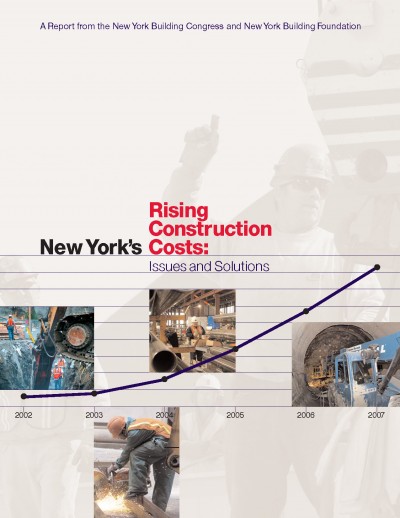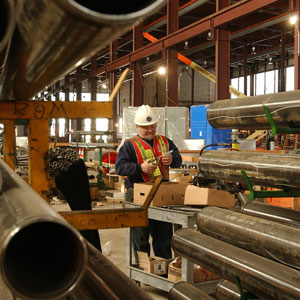
New York's Rising Construction Costs: Issues and Solutions
Some Potential Solutions
Identifying the key reasons for rising construction costs is the first step in formulating a strategy to address the conditions that threaten important infrastructure and development projects planned or underway, cooling the construction market that has been creating jobs, generating tax revenues and building a stronger, more competitive New York.
An important next step is action by government and the construction industry on potential cost-savings solutions.The City, State and virtually every industry sector has a hand in influencing construction costs and taking steps to control them. To keep the fate of ongoing and proposed public and private projects on the path to completion, sustain a healthy construction market and support the economic growth of New York, action is needed on a wide front.
Land Use
 With land costs in New York accelerating more than any other factor, there is a critical need to maximize the use and availability of sites. Government could expand the supply of land by:
With land costs in New York accelerating more than any other factor, there is a critical need to maximize the use and availability of sites. Government could expand the supply of land by:
- continuing to rezone idle or derelict industrial land, particularly waterfront and less contaminated sites;
- promoting remediation of brownfields; and
- considering the implementation of vacant land value surcharges in property taxation.
Procurement
The delivery of public and private construction projects on-time and on-budget begins with effective and fair procurement policies and practices. In particular, procurement policies and practices that promote balanced risk sharing between the owner and general contractor would help stimulate more bidding activity on projects and reduce the number of contingencies that contractors must incorporate into their bids to cover their risk exposure. By increasing the competition for jobs and reducing contingency costs, owners would realize substantial cost savings on projects, ultimately saving taxpayers and shareholders money and assuring the completion of important projects.
Government, private owners and management could create a more balanced risk-sharing environment and advance building faster, smarter and less expensively by:
- pursuing prompter payments, which could be accomplished by developing and implementing best practices for processing change orders quickly and efficiently and addressing delays in the close-out process (e.g., have contract documents stipulate that close-out will occur within three months of substantial completion, with damages paid for owner-delayed close-out);
- reducing or eliminating retainage requirements;
- including escalation clauses/indexes for commodities, materials and equipment in contracts; and
- lowering performance bond requirements to 50 percent of payment on jobs of $100 million or more.
Government could also generate significant cost reductions by:
- requiring quality-based selection for all public agencies, public authorities and public benefit corporations for the procurement of architectural, engineering and surveying services;
- issuing mobilization payments to subcontractors to ensure the availability of adequate cash flow to start the job on time and minimize delay;
- eliminating “No Damages for Delay” contract provisions; and
- incorporating a binding arbitration provision in agency contracts that provides for the resolution of disputes on jobs with a performance period of one or more years.
Workforce
 The backbone of any project is the workforce that makes the dream a reality. Whether design professionals, contractors, subcontractors, project managers or skilled laborers, all are needed at sufficient levels for meeting demand. Maximizing the productivity and supply of the workforce would help satisfy demand, relieving pressure on costs.
The backbone of any project is the workforce that makes the dream a reality. Whether design professionals, contractors, subcontractors, project managers or skilled laborers, all are needed at sufficient levels for meeting demand. Maximizing the productivity and supply of the workforce would help satisfy demand, relieving pressure on costs.
Government, private owners, management and labor could enhance workforce productivity and supply by increasing the use of project labor agreements on public and private projects.
Government, private owners and management could also enhance workforce productivity and supply by:
- exploring partnerships with national and international highly skilled engineering-based construction companies;
- emphasizing development of contractor and project management skills;
- encouraging construction manager-general contractor relationships in which large projects are divided into smaller packages;
- exploring ways to address the high insurance and judgment costs related to the State statutory imposition of absolute liability on owners, contractors and subcontractors for injuries to workers falling from any height during the construction period; and
- staggering bid-letting.
Labor could enhance workforce productivity and supply by:
- expanding the labor force through apprenticeship programs and facilitating the movement of new trades-people into the New York area to meet increased demand;
- promoting a Citywide master labor agreement for non-residential construction, in addition to the Citywide master labor agreement for residential construction that is currently under consideration by the Building & Construction Trades Council of Greater New York and Building Trades Employers’ Association (such an agreement would offer adjustments or changes in work rules for all unions and allow for changes in wage rates on a trade-bytrade basis); and
- continuing to address work rule and jurisdictional issues, such as improving the jurisdictional settlement process and reducing the costs associated with the division of labor and “hand-offs” between trades.
Construction and Operations
 To keep construction activity flowing, timely decisionmaking and the coordination of key activities, such as the delivery of supplies and issuance of permits, are essential. Government could use its executive, legislative and regulatory authority to:
To keep construction activity flowing, timely decisionmaking and the coordination of key activities, such as the delivery of supplies and issuance of permits, are essential. Government could use its executive, legislative and regulatory authority to:
- adopt response time requirements applicable to State and City agencies and the industry for drawings,change orders and approvals;
- implement congestion pricing and other traffic mitigation measures;
- develop an effective program for rationalizing security processes and procedures in a way that minimizes the impact on workforce productivity and material transport;
- examine establishment of a regional business command center for major development projects, in the manner of the Lower Manhattan Construction Command Center, to bundle commodity purchases, marshal material and equipment needs, oversee delivery logistics and serve as a clearinghouse for permits;
- encourage construction of a concrete batch plant, possibly on a barge, to ease ready-mix supply constraints and allow larger axle concrete vehicles on City streets;
- encourage development of assembly facilities in New York for construction materials fabricated abroad, like the sites in Connecticut for materials imported from Italy and used in New York;
- make New York City Department of Buildings and Department of Transportation construction permits coterminous with project timing or expiration of insurance, whichever occurs first, and fine contractors without insurance;
- support the creation of a public-private joint research center to test innovations and foster the use of new technologies, such as building information modeling, to achieve greater efficiency and quality of construction; and
- promote leadership and accountability in public agencies and authorities by offering competitive salaries to attract the most skilled and experienced individuals to senior executive and management positions.
Effecting Change:
What Everyone Can DoTo Reduce Construction Costs
To be effective, a strategy for cost containment and reduction requires even more than an understanding of cost conditions and a blueprint for dealing with them. It requiresthe commitment to follow through and act on implementing these cost-savings initiatives. It requires partnership. By supporting one another on cost-savings goals, government and the construction industry can work together to make building in New York more attractive and competitive.



